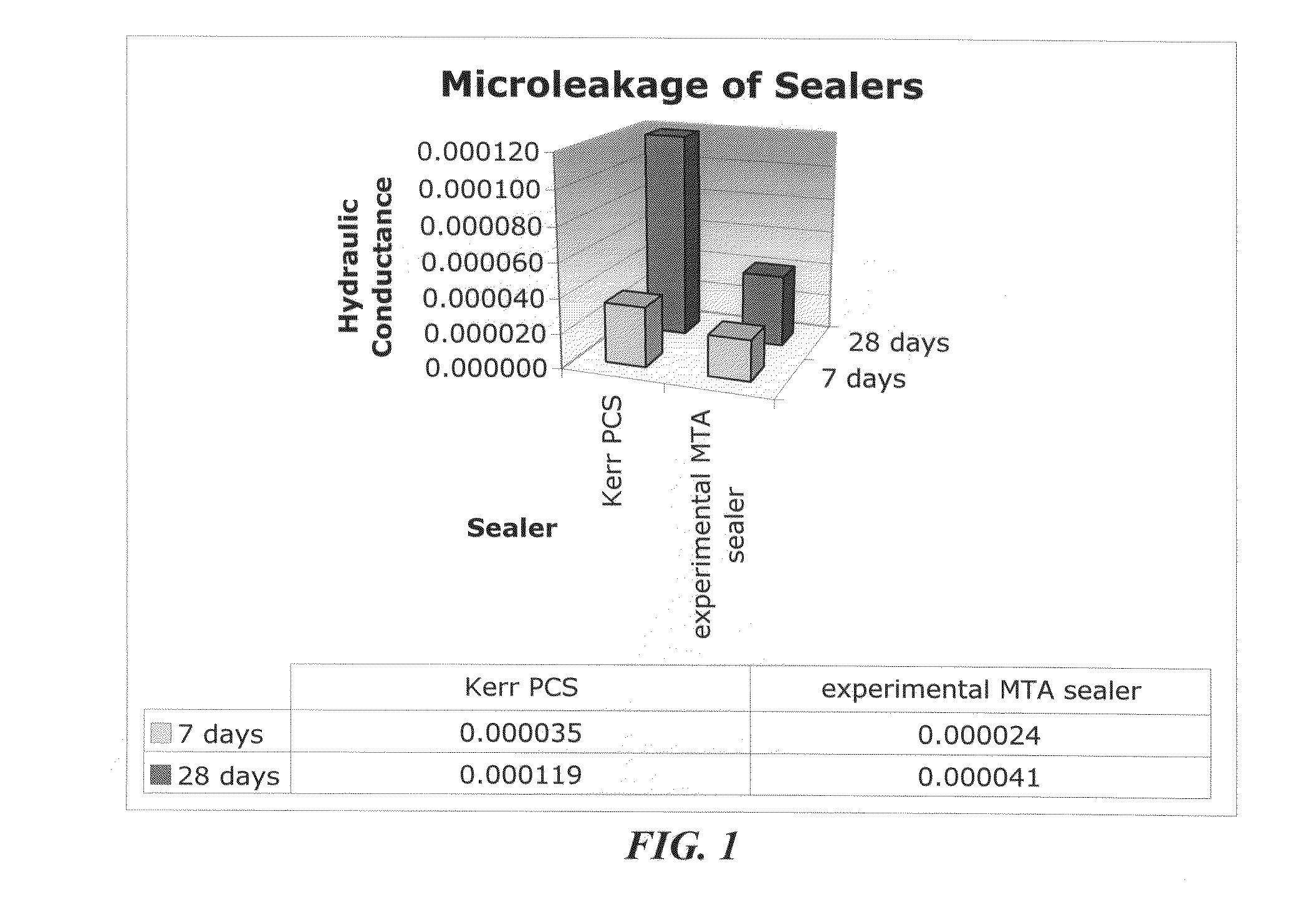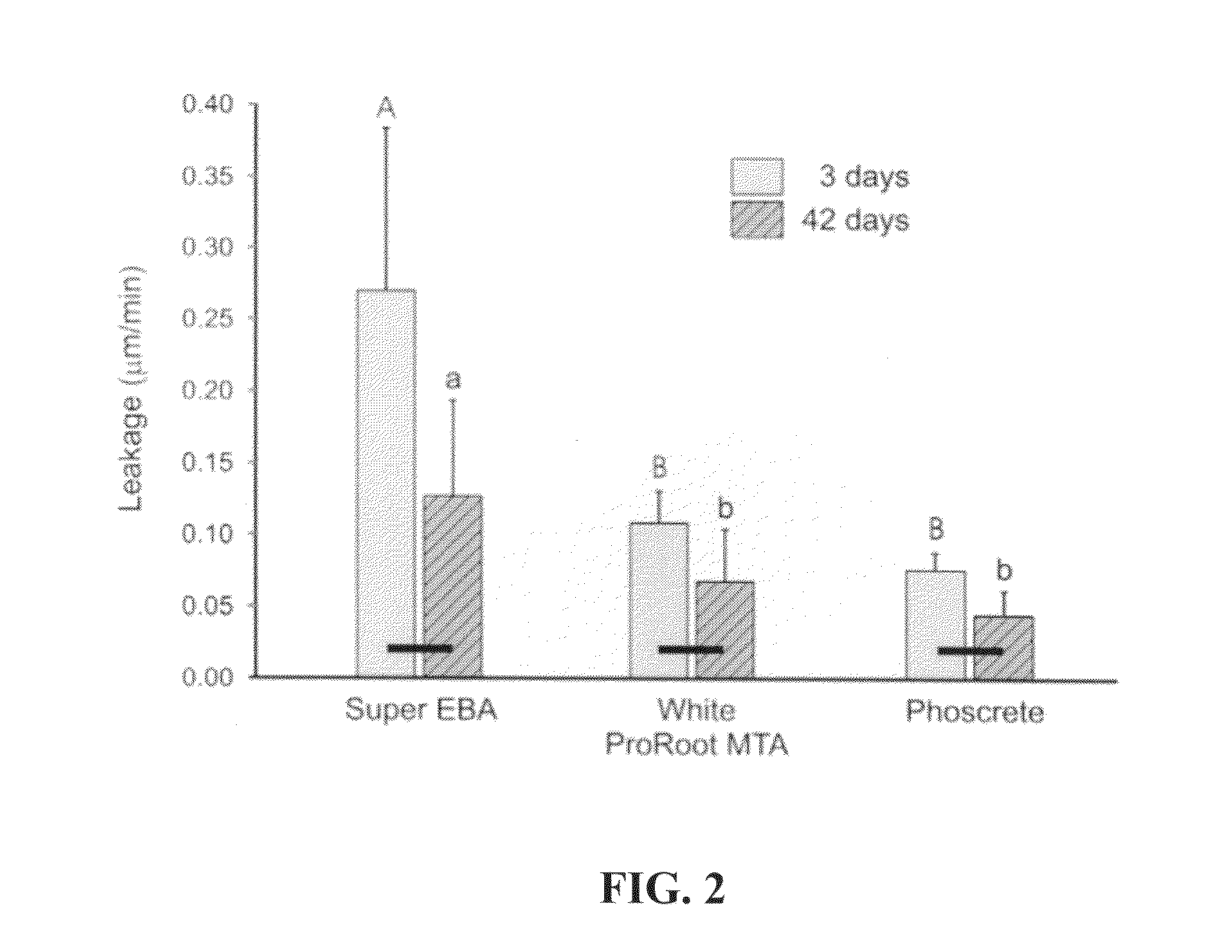Methods of treatment of the dental pulp and filling root canals using water-based material
a technology of dental pulp and root canal, applied in the direction of impression caps, teeth capping, antibacterial agents, etc., can solve the problems of pulp abscesses or inflammation, infection and inflammation, pulp caries so deep that it penetrates to the dentin tissue, etc., to achieve stable barrier to bacteria and enhance the growth of new bone and tissue surrounding the root tip
- Summary
- Abstract
- Description
- Claims
- Application Information
AI Technical Summary
Benefits of technology
Problems solved by technology
Method used
Image
Examples
example a
[0041]A root canal sealer was formulated with dentalcrete having 40 wt. % bismuth oxide and 60 wt. % of a mixture of calcium silicates, calcium aluminate, and calcium sulfate. (The approximate composition was 73 wt. % tricalcium silicate, 17 wt. % dicalcium silicate, 5 wt. % tricalcium aluminate, 1 wt. % tetracalcium ferrite, and 4 wt. % calcium sulfate.) The liquid carrier mixed with this powder contained 5 wt. % partially hydrolyzed polyvinyl acetate, 15 wt. % sodium n-dodceyl sulfate and 80 wt. % water. The resulting root canal sealer formulation is identified as “Experimental MTA” in this Example A and in FIG. 1.
[0042]The microleakage (hydraulic conductance) of root canal systems (human teeth) sealed with Experimental MTA was tested in vitro. Cleaning and shaping of the teeth as well as canal obturation were performed under an operating microscope (OPMI pico, Carl Zeiss Surgical, Inc., Thornwood, N.Y.). Detailed radiographic documentation of the pre-operative specimens, working ...
example b
[0053]The powdered particulate material described in Example A was used with various liquid carriers to prepare the compositions in this Example B. Particularly, the powder was mixed with the liquids listed in the following Table 1 to prepare various compositions. The concentration of powder in the composition was in the range of about 67 to about 80% by weight. When the powder was mixed with about 20% liquid, a putty-like composition was obtained. This composition could be used for root canal obturation, root-end repair, perforation repair, or other procedures. The sodium n-dodecyl sulfate improved the handling, but didn't accelerate the setting. The polyvinyl acetate may inhibit the setting when used alone. The combination of PVA with SDS, created the elasticity desired for some dental uses. The resulting mixtures were resistant to washout with a stream of water and hardened quickly enough to allow a clinician to proceed with covering the site and finishing the procedure. Various ...
example c
[0055]In this Example C, the powdered particulate material described in Example A was used, and different liquid carriers were tested as shown in Table 2. The concentration of powder in the composition was in the range of about 67 to about 75% by weight. The viscosities varied among these samples, but each sample was satisfactory for dental applications. The Steol material was a suitable substitute for the sodium n-dodecyl sulfate. Polyvinyl pyrrolidone was also a suitable material to use instead of polyvinyl acetate. However, when used alone, the polyvinyl pyrrolidone did not create an elastic mixture, although the setting was accelerated and seemed to add early strength to the mixtures.
Example C: Table 2.Liquid Carriers 1-4 (Concentration of Components by Weight %)Component123456789Water92.59291.58996929081.783Steol CA-4605554Ammonium laurethsulfatePolyvinyl acetate 872.533.57to 89% hydrolyzedSodium n-dodecyl105sulfatePolyvinyl pyrrolidone48108.310
PUM
| Property | Measurement | Unit |
|---|---|---|
| particle size | aaaaa | aaaaa |
| particle size | aaaaa | aaaaa |
| weight percent | aaaaa | aaaaa |
Abstract
Description
Claims
Application Information
 Login to View More
Login to View More - R&D
- Intellectual Property
- Life Sciences
- Materials
- Tech Scout
- Unparalleled Data Quality
- Higher Quality Content
- 60% Fewer Hallucinations
Browse by: Latest US Patents, China's latest patents, Technical Efficacy Thesaurus, Application Domain, Technology Topic, Popular Technical Reports.
© 2025 PatSnap. All rights reserved.Legal|Privacy policy|Modern Slavery Act Transparency Statement|Sitemap|About US| Contact US: help@patsnap.com


